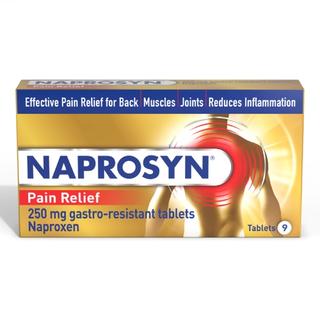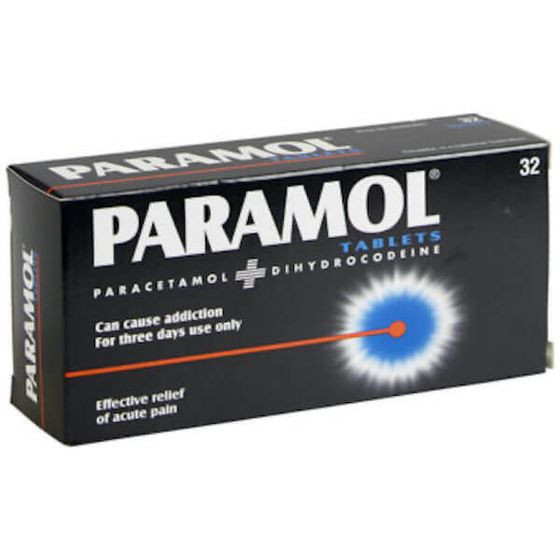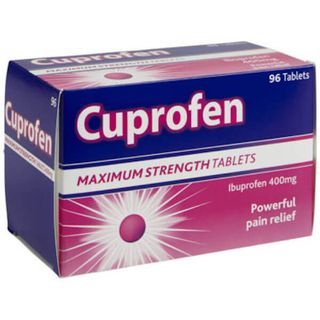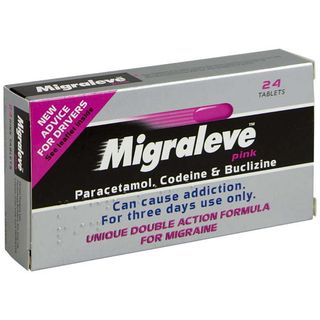
- Fast, discreet delivery
- 100% UK-based pharmacy
- Free advice and support
- We're rated 4.9 out of 5
Based on over 24,000 reviews collected on Google and Reviews.io.
We maintain the highest possible regulation for a UK online pharmacy, ensuring your experience is safe, and confidential.
Paramol Pain Relief - Available Online
When pain strikes and conventional over-the-counter painkillers like paracetamol and aspirin seem unable to help, Paramol tablets can provide fast and effective relief, usually within an hour.
Paramol is a brand name for co-dydramol, a dual-action analgesic opioid with two active painkilling ingredients – paracetamol (500mg) and dihydrocodeine (7.46mg). These get to work quickly, easing your discomfort.
Available without a prescription, Paramol tablets are an appropriate option for the short-term management of acute or moderate pain for adults and children over the age of 12. This can be anything from headaches, migraines and joint pain to post-injury or surgical pain.
Get the relief you need quickly and easily, just take a short consultation with our UK-based clinical team.
Paramol Tablets Summary
About Paramol
Paramol tablets are strong, over-the-counter analgesic painkillers. Paramol is a brand name for co-dydramol, which combines the active ingredients paracetamol and dihydrocodeine.
Paramol is designed for short-term pain management and should not be taken for more than three days. If you are still experiencing discomfort after this, please speak to a member of our clinical team for advice. Paramol tablets are available without a prescription and are suitable for adults and children over the age of 12.
How Does Paramol Work?
The active ingredients in Paramol are paracetamol and dihydrocodeine. These are both opioid analgesics. They work by interacting with the opioid receptors within your brain, interfering with the reception of pain signals transmitted to your brain along the spinal column.
Paracetamol also works as an antipyretic, regulating your body's temperature to prevent fevers that can often accompany pain, for people experiencing infections or inflammatory conditions.
How To Take Paramol
Adults and young people over the age of 16 should take one or two Paramol tablets every four to six hours as required. Paramol tablets should be taken either with or after meals.
Do not take more than eight tablets in any 24-hour period.
Children between the ages of 12 and 15 should only take one tablet every four to six hours as required. They should not take more than four tablets in any 24-hour period.
Do not ever take Paramol or more than three days. If you are still in discomfort after three days of use, please cease use and speak to a member of our clinical team.
Paramol Overdose
Like with all medication taking over the recommended dose can be harmful. If you think you have taken over the recommended dose of Paramol stop taking the medication straight away and speak to a doctor or pharmacist.
If you experience any of the following side effects following taking too much Paramol seek medical advice immediately:
- Becoming very sleepy
- Becoming dizzy
- Difficulty breathing
- Becoming unconscious
Can You Take Paramol With Ibuprofen?
It is safe to take Paramol with Ibuprofen or Aspirin.
It is important to note that you should not take Paramol with any other products that contain paracetamol as Paramol already contains your total dose. Be aware that most over the counter cold and flu medications contain paracetamol.
Can You Take Paramol With Amoxicillin?
It is safe to take Paramol with amoxicillin and all other antibiotics.
Several other medications may not be suitable to take at the same time as Paramol. Please see the Warnings section for a list of these medications.
Please ensure you have read the Patient Information Leaflet thoroughly before commencing treatment with Paramol.
Ingredients
The active ingredients in Paramol tablets are 500mg paracetamol and 7.46mg dihydrocodeine tartrate.
Other inactive ingredients include magnesium stearate, maize starch, povidone, hypromellose, titanium dioxide and macrogol 400.
Side Effects
Like all medicines, Paramol tablets come with some risk of side effects. These are usually mild and temporary and not everyone will experience them.
The most common include constipation, headaches, feeling dizzy or nauseous and fatigue.
In some rare cases, people may experience skin rashes, peeling or blistering of the skin or faster heartbeats. If you experience side effects that you can’t cope with, talk to a member of our clinical team. They will be able to advise on alternative pain relief solutions.
In case of allergic reaction such as difficulty breathing or a swelling of the skin of your face, seek emergency medical attention.
For full details of side effects see the Patient Information Leaflet.
Warnings
Paramol Other Medication
If you are taking other medication it may not be suitable for you to also take Paramol. Some medications that should not be taken with Paramol are listed below. For a full list of these medications please read the Patient Information Leaflet.
- Please be aware that Paramol contains paracetamol and must not be taken with other medicines containing paracetamol. Taking too much paracetamol can cause serious damage to you liver and kidneys.
- Monoamine oxidase inhibitors - to thin the blood, to treat nausea and vomiting, to reduce cholesterol
- Anti-anxiety, antipsychosis medication and sedatives
- Some medication to reduce blood pressure
- naloxone (used to treat addiction to opioids) or naltrexone (a drug used to treat alcohol addiction)
If you are currently taking another medication you should speak to your doctor or pharmacist before taking Paramol.
Paramol Addiction
Paramol is only suitable to take for up to 3 days as it contains dihydrocodeine which is an opioid analgesic.
Addiction is very unlikely if Paramol is taken as directed. Read the Patient Information Leaflet thoroughly for more information about how to take Paramol.
If you think you may be addicted or are experiencing withdrawal symptoms speak to a doctor or pharmacist as soon as possible.
Signs of addiction may include:
- Finding it difficult to stop taking Paramol
- Finding you need to take more Paramol for it to have an effect
- Finding you are needing to take Paramol more often
Withdrawal symptoms may include:
- Feeling agitated
- Feeling more nervous than usual
- Sweating more than usual
- Shaking
Paramol and Alcohol
It is not recommended to drink alcohol when taking Paramol as the alcohol can increase the likeliness of you becoming drowsy as a side effect of the dihydrocodeine.
It is also not recommended to drink alcohol while taking Paramol as drinking alcohol while taking paracetamol can increase your risk of experiencing liver damage.
Paramol in Pregnancy and Breastfeeding
Paramol is not suitable for consumption when pregnant or breastfeeding. If you are experiencing pain at this time speak to a doctor or pharmacist.
Paramol and Driving
The dihydrocodeine included in Paramol can impair mental function, cause blurred vision and make you drowsy it is therefore not recommended to drive or operate heavy machinery until you know how this medication affects you.
Under the Drug Driving Act, it is now an offence to drive if a medication affects your ability to drive. If you are concerned about your ability to drive when taking Paramol speak to a doctor or pharmacist.
Paramol Tablets reviews
Paramol FAQs
Can You Take Paramol And Ibuprofen At The Same Time?
It is generally safe to take Paramol alongside anti-inflammatory painkillers like ibuprofen or aspirin. Using analgesics and anti-inflammatories together can help target the pain while also easing the inflammation that causes the pain, making it a useful combination for joint pain, headaches and migraines.
If you take Paramol and ibuprofen together, be careful to stagger the doses by 30-60 minutes as this is the time each medication will take to get to work. Always wait to see if one form of pain relief is sufficient before supplementing it with another.
Paramol should not, however, be taken alongside other opioid analgesics such as tramadol, codeine or oxycodone. Doing this can result in serotonin syndrome, which is potentially fatal, and increases addiction risk.
How Does Paramol Work?
Paramol contains dihydrocodeine, which is an opioid analgesic. It works by interacting with your nervous system, preventing pain signals transmitted from your body along your spinal column to your brain's opioid receptors.
Is Paramol Stronger Than Cocodamol?
Paramol and Cocodamol are both mild opioids that work in the same way. However, their parity in terms of strength varies depending on the dose. Paramol tablets contain 500mg paracetamol and 7.46mg dihydrocodeine. Cocodamol, on the other hand, contains 500mg paracetamol and either 8mg, 15mg or 30mg codeine phosphate.
While lower strength Cocodamol is available without a prescription, higher strength options require a consultation with a member of our clinical team.
When Should You Not Take Paramol?
You should avoid taking Paramol if you have certain conditions such as breathing difficulties, severe diarrhoea, high blood pressure within your head, head injuries, arrhythmia, underactive thyroid or adrenal glands, enlarged prostate, bowel problems, gallstones or difficulty passing urine.
You should not drink alcohol while taking Paramol. This medication is not suitable if you have a history of drug or alcohol dependency.
Do not use Paramol if you are elderly, pregnant or breastfeeding. Do not use it if you are allergic to any of the ingredients listed above.
Do not take any more Paramol if you have already been taking it for three days. If you are still in pain, speak to a member of our clinical team.
If you are at all unsure whether or not Paramol is the right choice for you, speak to one of our UK-licensed clinicians. Our team is always on hand to help you make the right choice.
How Quickly Does Paramol Start Working?
Paramol is fast-acting and generally gets to work within one hour. In some cases, it may take up to two hours to notice the full effect as each body metabolises the active ingredients slightly differently.
What Types Of Pain Can Paramol Help With?
Paramol can help with pain from a range of sources, including headaches and migraines, dental pain, muscle and joint pain, period pain, earache and the management of post-surgical or post-injury pain.
It's important to note that Paramol should not be taken for more than three days. If you need longer-term pain management, a member of our clinical team will be happy to advise you.
How Often Can I Take Paramol Tablets?
Adults aged 16 and over can take one or two tablets every four-to-six hours as needed. For young people aged 12 to 15, one tablet every four to six hours.
Do not take more than eight Paramol tablets per day if you are an adult or four if you are between the ages of 12 and 15.
Is Paramol Addictive Or Habit-Forming?
Like all opioid painkillers, Paramol can be addictive if misused by taking more often or in higher dosages than directed. Your body can develop dependencies on opioids, which is why it's so important never to exceed the recommended dose.
If you are worried about dependency and would prefer an alternative pain management solution, our clinical team will be happy to help.
Does Paramol Interact With Other Medications?
Yes, Paramol can have interactions with other medicines.
These include the class of antidepressants called Monoamine Oxidase Inhibitors (MAOIs), blood thinners such as warfarin, nausea medications like domperidone or metoclopramide, cholesterol treatments like cholestyramine, anxiety medications such as Hydroxyzine, anaesthetics, hypnotics, diuretics, sedatives, antipsychotics like Phenothiazine, anti-diuretics like loperamide or any neuromuscular blockers (antimuscarinics), malaria medications such as quinidine, blood pressure medications such as mexiletine, antibiotics, and reflux medications including cisapride and cimetidine.
If you have a chronic condition or take regular medication, our clinical team can advise you on the best pain management option online.
Where Can I Get Paramol Online?
If you think Paramol is the right option to manage your pain, you can get it online following a short consultation with our dedicated clinical team.
We are a 100% UK-based online pharmacist that can provide you with the support you need to say goodbye to pain.
Related Treatments
Visit our Pain page for treatments, advice and FAQs.
Ordering as easy as 1, 2, 3
1. Find the ideal treatment
2. Get a free consultation
3. Enjoy speedy delivery



